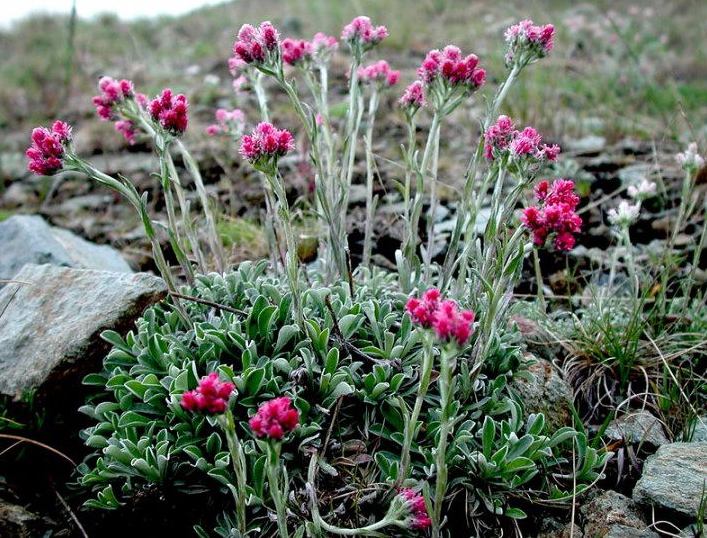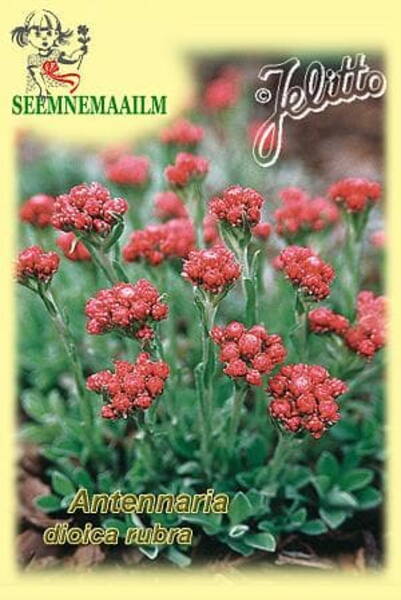Your shopping cart is empty!
Catsfoot "Rubra" (pussytoes, cudweed, stoloniferous pussytoes)
Antennaria dioica var. rosea
3.41€
Ex Tax: 2.75€
Ex Tax: 2.75€
Pussytoes "Rubra" (Cats Paw, cudweed) - Antennaria dioica var. rosea.
A charming plant with a fitting name!
An unpretentious ground cover perennial 8-10 cm high with a very pretty appearance - the leaves are covered with fluffy hairs, giving the plant a grayish-silver hue.
The flowers are collected in inflorescences-baskets up to 1 cm in diameter, it looks very atypical and spectacular, retaining its decorative effect throughout the season.
Creeping shoots, rooting, forms a sprawling bush 10-15 cm high and 20-25 cm in diameter.
The leaves are whole, gray-green, pubescent, collected in a basal rosette, from which numerous creeping shoots grow.
Flowering stems are erect, ending in inflorescences. Blooms from late May - early June 40-50 days.
Used for rocky hills, as a groundcover.
Agrotechnics.
The plant is very winter hardy. Prefers an open sunny place and poor slightly acidic soils. For seedlings, sowing is done in March in seedling boxes.
Seeds are slightly pressed into the soil, do not sprinkle with earth. The landing container is covered with glass and placed in a bright place.
The first 3 weeks the temperature should be +5+10°C, then at a soil temperature of +18+21°C shoots appear on 14-21 days.
After the emergence of seedlings, the shelter is removed and the planting is transferred to a lighted place.
Seedlings grow very slowly, need constant moisture, they dive into separate pots after 14 weeks.
Seedlings are planted in open ground in August-September, maintaining a distance of 15 cm between plants.
A charming plant with a fitting name!
An unpretentious ground cover perennial 8-10 cm high with a very pretty appearance - the leaves are covered with fluffy hairs, giving the plant a grayish-silver hue.
The flowers are collected in inflorescences-baskets up to 1 cm in diameter, it looks very atypical and spectacular, retaining its decorative effect throughout the season.
Creeping shoots, rooting, forms a sprawling bush 10-15 cm high and 20-25 cm in diameter.
The leaves are whole, gray-green, pubescent, collected in a basal rosette, from which numerous creeping shoots grow.
Flowering stems are erect, ending in inflorescences. Blooms from late May - early June 40-50 days.
Used for rocky hills, as a groundcover.
Agrotechnics.
The plant is very winter hardy. Prefers an open sunny place and poor slightly acidic soils. For seedlings, sowing is done in March in seedling boxes.
Seeds are slightly pressed into the soil, do not sprinkle with earth. The landing container is covered with glass and placed in a bright place.
The first 3 weeks the temperature should be +5+10°C, then at a soil temperature of +18+21°C shoots appear on 14-21 days.
After the emergence of seedlings, the shelter is removed and the planting is transferred to a lighted place.
Seedlings grow very slowly, need constant moisture, they dive into separate pots after 14 weeks.
Seedlings are planted in open ground in August-September, maintaining a distance of 15 cm between plants.

Catsfoot, pussytoes, cudweed, life everlasting, mountain everlasting, stoloniferous pussytoes, "Cats Paw". Bot. syn.: Antennaria hyperborea D. Don, Antennaria insularis Greene, Gnaphalium dioicum L.












